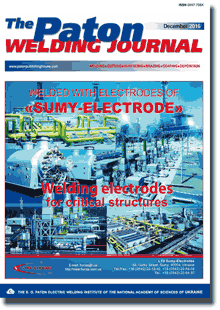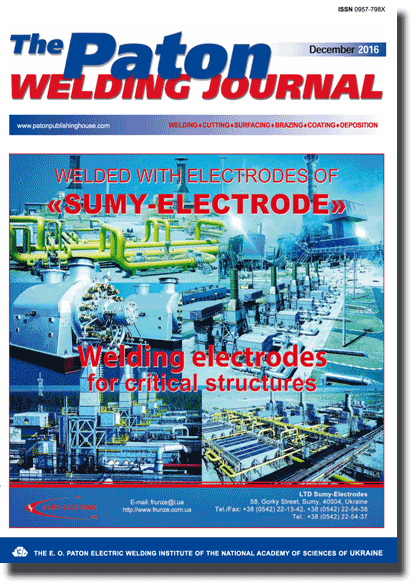| 2016 №12 (01) |
DOI of Article 10.15407/tpwj2016.12.02 |
2016 №12 (03) |

The Paton Welding Journal, 2016, #12, 9-12 pages
Finite-element modelling of stress-strain state in weldability tests (PVR-TEST)
K.A. Yushchenko, E.A. Velikoivanenko, N.O. Chervyakov, G.F. Rozynka And N.I. Pivtorak
E.O. Paton Electric Welding Institute, NASU 11 Kazimir Malevich Str., 03680, Kiev, Ukraine. E-mail: office@paton.kiev.ua
Abstract
Hot cracks appearing in process of welding are an important problem determining weldability of number of structural materials. Regardless the fact that this phenomenon is widely investigated in course of many decades a nature of hot crack appearance is still a relevant problem for number of current alloys in fusion welding. To reach wider understanding of a mechanism of hot crack formation a finite-element method was used for mathematical modelling of PVR-Test. Realizing the mathematical model employing the experimental data, received as a result of such testing, allowed getting stress and strain distribution in the crack formation zones. The zones of plastic strain positive increments, promoting crack formation, were found for a range of brittleness temperature interval. Prediction of the zones of higher susceptibility to hot crack appearance as a result of decrease of material ductility well agrees with the experimental investigations. 8 Ref., 1 Table, 4 Figures.
Keywords: hot cracks, weldability testing, welding, PVR-Test, nickel alloys, finite-element method
Received: 19.10.16
Published: 24.01.17
References
- Boellinghaus, T., Lippold, J., Cross, C. (2016) Cracking phenomena in welds. Springer.
- ISO/TR 17641-3:2005: Destructive tests on welds and metallic materials — hot cracking tests for weldments: Arc welding processes. Pt 3: Externally loaded tests.
- Fink, C., Keil, D., Zinke, M. (2012) Evaluation of hot cracking susceptibility of Ni-based alloys by the PVR-t Welding in the World, 56(7/8), 37–43.
- Vallant, R.,Cerjak, H. The influence of different Nb/C ratio in Ni-base weld metals type 70/20 and 70/15 on the hot cracking susceptibility. IIW Doc. II-1535–04.
- Prokhorov, N.N. (1956) Problem of metal strength in welding during solidification. Proizvodstvo, 6, 5–11.
- Yushchenko, K.A., Savchenko, V.S., Chervyakov, N.O. et al. (2011) Comparative hot cracking evaluation of welded joints of alloy 690 using filler metals FM 52 and 52 MSS. Welding in the World, 55(9/10), 28–35. https://doi.org/10.1007/BF03321317
- Lindgren, L.-E. (2006) Numerical modeling of welding. Computer Methods in Applied Mechanics and Engineering, 195, 6710–6736. https://doi.org/10.1016/j.cma.2005.08.018
- Makhnenko, V.I. (1976) Calculation methods for investigation of kinetics of welding stresses and strains. Kiev: Naukova Dumka.
Suggested Citation
K.A. Yushchenko, E.A. Velikoivanenko, N.O. Chervyakov, G.F. Rozynka And N.I. Pivtorak (2016) Finite-element modelling of stress-strain state in weldability tests (PVR-TEST). The Paton Welding J., 12, 9-12.The cost of subscription/purchase order journals or individual articles
| Journal/Currency | Annual Set | 1 issue printed |
1 issue |
one article |
| TPWJ/USD | 384 $ | 32 $ | 26 $ | 13 $ |
| TPWJ/EUR | 348 € | 29 € | 24 € | 12 € |
| TPWJ/UAH | 7200 UAH | 600 UAH | 600 UAH | 280 UAH |
| AS/UAH | 1800 UAH | 300 UAH | 300 UAH | 150 UAH |
| AS/USD | 192 $ | 32 $ | 26 $ | 13 $ |
| AS/EUR | 180 € | 30 € | 25 € | 12 € |
| SEM/UAH | 1200 UAH | 300 UAH | 300 UAH | 150 UAH |
| SEM/USD | 128 $ | 32 $ | 26 $ | 13 $ |
| SEM/EUR | 120 € | 30 € | 25 € | 12 € |
| TDNK/UAH | 1200 UAH | 300 UAH | 300 UAH | 150 UAH |
| TDNK/USD | 128 $ | 32 $ | 26 $ | 13 $ |
| TDNK/EUR | 120 € | 30 € | 25 € | 15 € |
AS = «Automatic Welding» - 6 issues per year;
TPWJ = «PATON WELDING JOURNAL» - 12 issues per year;
SEM = «Electrometallurgy Today» - 4 issues per year;
TDNK = «Technical Diagnostics and Non-Destructive Testing» - 4 issues per year.


